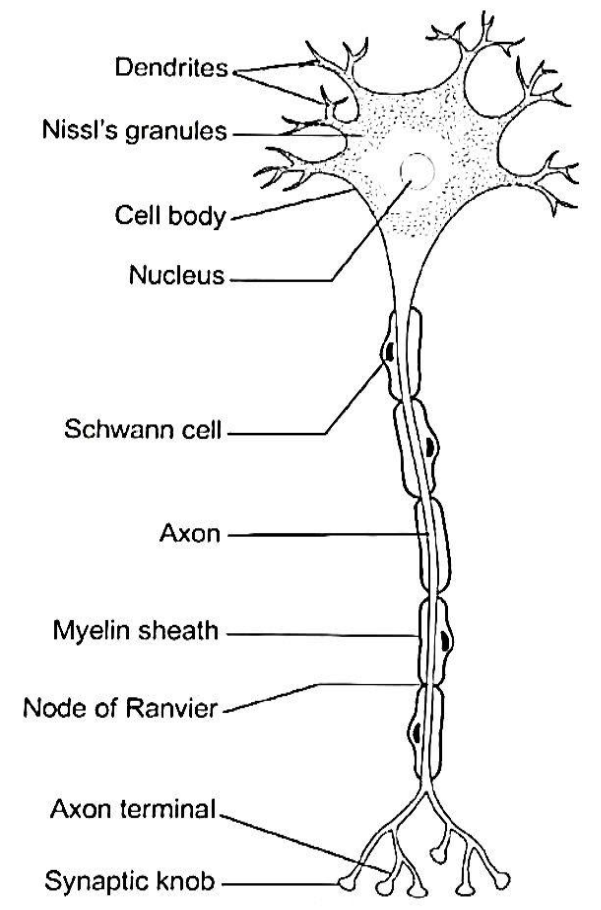
Cell body of neuron is called
A) Nissl body
B) Neurolemma
C) Oligodendrocyte
D) Perikaryon
Answer
499.2k+ views
Hint: Neurons are structural and functional units of Nervous System. These contain the nucleus and the cytoplasm around it. Nucleus is known as ‘Karyon’.
Complete Answer:
Nervous system consists of Neurons and Neuroglial cells. Neurons are less than 50% while Neuroglial cells are more than 50%. Neurons are of various types depending on the number of processes. These are Unipolar, Bipolar, Multipolar and Pseudounipolar.
Maximum number of neurons are Multipolar.
Structure of Multipolar neurons is as follows:

It consists of many processes around the cell body:
1) There are short processes that carry impulses towards the cell body. These are dendrites. These further contain branches called dendrons.
2) The main process arising from the cell body that carries impulses away from the cell body is the Axon.
3) Thus the multipolar neurons contain one Axon and many Dendrites.
4) The cell body contains nucleus and Nissl granules. Nissl granules are Ribosomes that take part in protein synthesis.
5) The end of the Axon terminates into the Axon terminal that forms Synaptic knobs that contain vesicles filled with neurotransmitters.
6) The cell body is around the nucleus. Nucleus is karyon so the cell body is around and hence it is Perikaryon or Cyton.
7) The Multipolar neuron can be Myelinated or Unmyelinated. This is due to the presence or absence of Myelin sheath.
8) Neuroglial cells are supporting cells and not for conduction of impulses. These cells are Schwann cells, Oligodendrocytes, Microglial cells, Ependyma, etc.
Hence the correct answer is option ‘D’.
Note: The cell is a structural and functional unit of the life. Thus depending on different functions, the cells differ in structures too.
Example:
1) The neurons are for conduction and hence possess processes
2) Muscle cells undergo contraction and relaxation and hence are elongated
3) RBC’s circulate through the blood and hence are biconcave in shape
Complete Answer:
Nervous system consists of Neurons and Neuroglial cells. Neurons are less than 50% while Neuroglial cells are more than 50%. Neurons are of various types depending on the number of processes. These are Unipolar, Bipolar, Multipolar and Pseudounipolar.
Maximum number of neurons are Multipolar.
Structure of Multipolar neurons is as follows:

It consists of many processes around the cell body:
1) There are short processes that carry impulses towards the cell body. These are dendrites. These further contain branches called dendrons.
2) The main process arising from the cell body that carries impulses away from the cell body is the Axon.
3) Thus the multipolar neurons contain one Axon and many Dendrites.
4) The cell body contains nucleus and Nissl granules. Nissl granules are Ribosomes that take part in protein synthesis.
5) The end of the Axon terminates into the Axon terminal that forms Synaptic knobs that contain vesicles filled with neurotransmitters.
6) The cell body is around the nucleus. Nucleus is karyon so the cell body is around and hence it is Perikaryon or Cyton.
7) The Multipolar neuron can be Myelinated or Unmyelinated. This is due to the presence or absence of Myelin sheath.
8) Neuroglial cells are supporting cells and not for conduction of impulses. These cells are Schwann cells, Oligodendrocytes, Microglial cells, Ependyma, etc.
Hence the correct answer is option ‘D’.
Note: The cell is a structural and functional unit of the life. Thus depending on different functions, the cells differ in structures too.
Example:
1) The neurons are for conduction and hence possess processes
2) Muscle cells undergo contraction and relaxation and hence are elongated
3) RBC’s circulate through the blood and hence are biconcave in shape
Recently Updated Pages
Express the following as a fraction and simplify a class 7 maths CBSE

The length and width of a rectangle are in ratio of class 7 maths CBSE

The ratio of the income to the expenditure of a family class 7 maths CBSE

How do you write 025 million in scientific notatio class 7 maths CBSE

How do you convert 295 meters per second to kilometers class 7 maths CBSE

Write the following in Roman numerals 25819 class 7 maths CBSE

Trending doubts
A boat goes 24 km upstream and 28 km downstream in class 10 maths CBSE

The Equation xxx + 2 is Satisfied when x is Equal to Class 10 Maths

What are the public facilities provided by the government? Also explain each facility

Difference between mass and weight class 10 physics CBSE

Statistics in singular sense includes A Collection class 10 maths CBSE

Why is there a time difference of about 5 hours between class 10 social science CBSE




